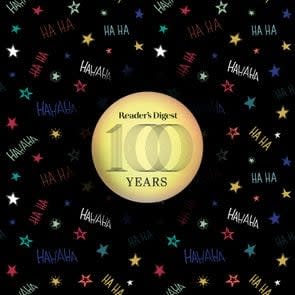32 of the Most Memorable Reader’s Digest Stories Ever
In honor of the 100th anniversary of Reader’s Digest, we are looking back at some of our best moments from the past 10 decades. Head here for more on our milestone anniversary.
By our very rough calculations, Reader’s Digest has published some 35,000 articles in nearly 1,200 issues. Our century-long table of contents features stories of every stripe, from short essays to sprawling book excerpts. And that’s not counting all the jokes, anecdotes, and other elements that help make what DeWitt Wallace called his “Little Magazine.”
These small pages have held some very big bylines from the likes of U.S. presidents, first ladies, world leaders, poets, comedians, sports legends, musicians, inventors, and the biggest contributors of all: everyday Americans with a story to tell. These are some of our proudest moments.
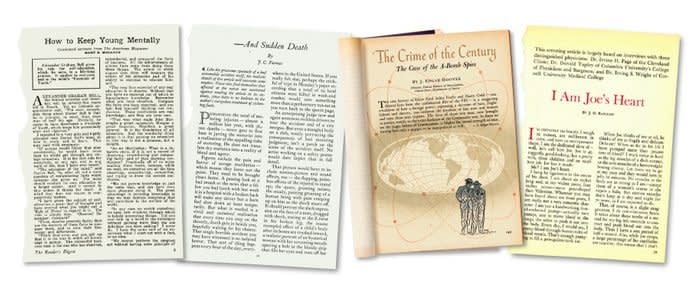
1. “How to Keep Young Mentally” by Mary B. Mullett, from the American Magazine, February 1922
The first article in the first issue highlighted inventor Alexander Graham Bell and his belief in lifelong learning: “The first essential of any real education is to observe. Observe! Remember! Compare!” It was an apt beginning, reflecting our self-educated founder’s endless curiosity.
2. “Does Tobacco Injure the Human Body?” by Irving Fisher, from the Dearborn Independent, November 1924
As the ’20s roared on, Americans found even more reasons to light up. While doctors appeared in ads extolling the benefits of certain brands of smokes, Reader’s Digest was blowing the whistle. The story cites a study that found smoking was “one of the very significant reasons why fewer men than women attain old age.” Our drumbeat warning continued, with anti-smoking articles through the decades, including “Juul Hooks a New Generation” from the New York Times in May 2020.
Cigarette advertising on TV and radio was outlawed in 1971, and print ads were later restricted, but that didn’t affect Reader’s Digest’s bottom line because the magazine had never accepted tobacco ads. Funnily enough, the magazine’s persistent coverage of the ills of tobacco is the primary plotline in Mad Men’s pilot episode.
3. “—And Sudden Death” by J.C. Furnas, August 1935
The editor’s note at the beginning of the issue sets up this graphic account of the preventable carnage of a car wreck: “Like the gruesome spectacle of a bad automobile accident itself, the realistic details of this article will nauseate some readers.” Within three months, four million reprints of the story had been handed out with license plates at motor vehicle departments around the country. The New York Times later called it “perhaps the most widely read magazine article ever published anywhere.”
4. “Bread, de Luxe” by J.D. Ratcliff, December 1939
Margaret Rudkin began baking bread for her allergy-prone son in 1937, grinding wheat in a coffee mill to preserve the bran and B vitamins lost in commercial flour. After this article about the success of her small business, so many readers wanted a slice that Rudkin borrowed $15,000 to move to a larger location. To buy her bread today, look for Pepperidge Farm on grocery shelves.
5. “The Doctor of Lennox” by A.J. Cronin, September 1939
In our enduring series “My Most Unforgettable Character,” contributors wrote about the person who made the biggest impact on their lives. For Cronin, who wrote the first in the series, it was his shy boyhood friend Carry, who became a well-respected country doctor. Other “Unforgettables” include baseball manager Branch Rickey by Jackie Robinson; Thomas Edison by his son Charles Edison; Eleanor Roosevelt by journalist Emma Bugbee; and Chuck Jones by his cartoon creation Bugs Bunny.
6. “Surprise Endings” by Anthony Abbot, from True, December 1945
The first Drama in Real Life told the story of Il Diavolo, a Chicago mob boss who bizarrely lost 50 pounds in a prison hunger strike. Diavolo believed that if he was light enough at his hanging, his accomplices could revive him. Police found a doctor, nurse, and medical supplies in the hearse. “Fiction writers, of course, do not tell such tales. Because who would believe them?” wrote Abbot.
7. “Tunnel to Freedom” by Flight Lt. Paul Brickhill of the Royal Australian Air Forces, as told to Allan A. Michie, December 1945
In the real-life Great Escape, 76 Allied prisoners sprung themselves from a German POW camp by digging a 336-foot tunnel under a stove. The tale became a 1963 film starring Steve McQueen and Richard Attenborough.
8. “The Crime of the Century” by J. Edgar Hoover, May 1951
The head of the FBI reconstructed how the criminals who stole atomic bomb secrets from the United States were apprehended.
9. “The Girl Who Was Anne Frank” by Louis de Jong, October 1957
The director of the Netherlands State Institute for War Documentation told of Anne Frank’s life before she and her family went into hiding, adding often-overlooked context to her famous diary. Her father, Otto Frank, didn’t want it published, but when friends pointed out that his daughter had wanted to publish a book about the annex, he agreed. “Oh, Mr. Frank,” wrote one American girl, “she is so much like me that sometimes I do not know where myself begins and Anne Frank ends.”
10. “Mr. Muhammad Speaks” by Alex Haley, March 1960
Our new contributing editor was the first to write for a major national publication about the Nation of Islam, its leader Elijah Muhammad, and brash young spokesman Malcolm X. This laid the groundwork for The Autobiography of Malcolm X, ghostwritten by Haley.
11. Travels with Charley by John Steinbeck, June 1964
The June 1964 Book Section excerpts Travels with Charley, Steinbeck’s last book before his death in 1968. The work chronicles his road trip with his trusty poodle, Charley. According to Steinbeck’s son, the author knew he was dying and wanted to see his country one last time. “From start to finish, I found no strangers. If I had, I might be able to report them more objectively. But these are my people, and this is my country.”
12. “I Am Joe’s Heart” by J.D. Ratcliff, April 1967
“I’m certainly no beauty. I weigh 12 ounces, am red-brown in color, and have an unimpressive shape. I am the dedicated slave of—well, let’s call him Joe. Joe is 45, ruggedly good-looking, has a pretty wife, three children, and an excellent job. Joe has it made.” So began the first article of a popular health series that would continue until 1990, in which readers heard detailed accounts from 36 body parts of Joe and of his female counterpart, Jane.
13. “Dark Yesterdays, Bright Tomorrows” by Martin Luther King Jr., from the book Strength to Love, June 1968
Prophetic words, both poignant and powerful, were excerpted from Martin Luther King Jr.’s collection of sermons as the country reeled from his assassination.
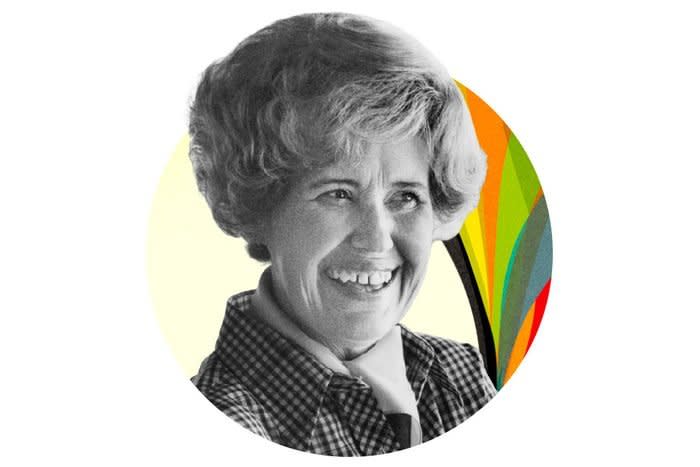
14. Erma Bombeck
Erma Bombeck’s writing career began modestly—one of her earliest columns appeared in the Dayton Shopping News. But when the beloved author needed a kidney transplant in 1996, no fewer than 30 readers volunteered theirs (alas, no matches). Bombeck is also responsible for some of the funniest headlines to appear on our pages, including “If Life Is a Bowl of Cherries—What Am I Doing in the Pits?” (July 1978) and “65 Million Women Want My Husband!” (May 1980).
15. “Our Haunted House on the Hudson” by Helen Herdman Ackley, May 1977
Helen Herdman Ackley’s spirited account of the ghostly companions residing in her family home came back to haunt her when her home buyer got spooked. The now-famous “Ghostbusters case” determined that failing to disclose that a house is haunted might be a legit reason for a buyer to back out of a deal.
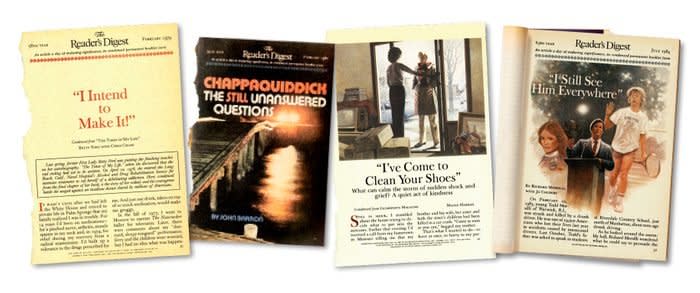
16. “I Intend to Make It!” by Betty Ford and Chris Chase, from the book The Times of My Life, February 1979
First Lady Betty Ford was putting the finishing touches on her autobiography, The Times of My Life, which was to be copublished by the Reader’s Digest Association, when she discovered that the real ending had yet to be written. Ford entered a rehab facility to treat her alcohol and prescription drug addiction, then bravely shared her story. In her own memoir, Barbara Bush wrote of her fellow first lady, “She transformed her pain into something great for the common good. Because she suffered, there will be more healing. Because of her grief, there will be more joy.”
17. “Chappaquiddick: The Still Unanswered Questions” by John Barron, February 1980
In November 1979, Senator Edward Kennedy was poised to seize the Democratic nomination for president from incumbent Jimmy Carter. Then came this story, which recounted in shocking detail the 1969 car accident that left campaign worker Mary Jo Kopechne dead, contradicting Kennedy’s account. Barron, a naval intelligence officer and Cold War spy turned investigative reporter, joined Reader’s Digest’s Washington, D.C., bureau in 1965 and filed more than 100 articles before his retirement.
18. “Return of a Runaway Child” by Gary Turbak, November 1982
Georgia teenager Tammy Hendley recognized one of the missing children in a July 1982 Reader’s Digest article (“Missing: 100,000 Children a Year,” from Kiwanis Magazine) as Tammy Ann Pickerman, a nurse’s aide who worked alongside her mother. The story and Hendley’s eagle eyes would soon reunite Pickerman—real name Marian Wavie Batson—with her family, who had spent two-and-a-half years looking for her.
19. “Maya’s Journey Home” by Maya Angelou, from the book I Know Why the Caged Bird Sings, September 1982
“Creativity is all of a piece, beginning in childhood. … Some terrible and wonderful things happened in Stamps, Arkansas, to Maya Angelou as a little girl. There, as she relates in I Know Why the Caged Bird Sings, her nascent creativity was first threatened and then forged,” reads an introduction by PBS host Bill Moyers. This excerpt reveals how Angelou and her classmates, feeling disrespected by a guest speaker at their high school graduation, proudly joined together for “Lift Ev’ry Voice and Sing.”
20. “I’ve Come to Clean Your Shoes” by Madge Harrah, from Guideposts, December 1983
The morning of a family funeral, an acquaintance shows up unannounced and says, “I’ve come to clean your shoes.” He spends the day quietly shining every pair in the house. The writer ends with this: “Now, whenever I hear of an acquaintance who has lost a loved one, I try to think of one specific task that suits that person’s need—such as washing the car, taking the dog to the kennel, or house-sitting during the funeral. And if the person says, ‘How did you know I needed that done?’ I reply, ‘It’s because a man once cleaned my shoes.’”
21. “I Still See Him Everywhere” by Richard Morsilli and Jo Coudert, July 1984
After Richard Morsilli’s 13-year-old son, Todd, was killed by a drunk driver, the brokenhearted dad spoke honestly and graphically about the incident to students at Riverdale Country School in New York City. This was our sixth article in four years to warn of the dangers of drunk driving, and it led to a national campaign in which we offered $500,000 in scholarships to high school students who developed the programs that best promoted sober driving.
22. “Strange Encounter on Coho Creek” by Morris Homer Erwin, May 1987
A prospector spends days camping in the Alaskan wilderness, working hard to earn the trust of a mother wolf snared in a trap before she and her four pups starve to death. Eventually, he is able to free her. Four years later, he encounters a wolf in the same meadow. Yes, the same wolf. When we shared this classic online in 2019, it went viral, and it has now been read by many millions online and in print.
23. “Papa Was an American” by Leo Buscaglia, February 1992
This quintessential immigrant story tells of Rocco Buscaglia, who landed in the United States in 1911 and was as enthusiastic about becoming an American as he was about being born an Italian. His son, Leo, grew up to be a renowned self-help author who praised the power of relationships and earned the honorary title Dr. Love.
24. “Not in Our Town!” by Edwin Dobb, November 1994
When a spate of anti-Semitic vandalism swept Billings, Montana, the residents struck back by placing a menorah in the window of every home in town. Their actions were inspired by King Christian of Denmark, who was said to have instructed his citizens to wear the Star of David after Nazis ordered Jewish citizens to wear them. The Billings show of solidarity ignited the Not in Our Town movement, an effort that continues today, helping community leaders around the country fight intolerance and create safe, inclusive communities.
25. “How Honest Are We?” by Ralph Kinney Bennett, December 1995
Our famous “wallet drop” set up the ultimate test of honesty: If we left wallets in cities around the country, how many would be returned? Well over half, it turned out—67 percent. The most honest city? Seattle, whose upstanding residents returned nine out of ten wallets. We repeated the experiment internationally, with less impressive results: Just 47 percent of wallets were returned.
26. “Horror in the Heartland” by Henry Hurt, May 1996
Henry Hurt, who had been a Reader’s Digest editor at large since 1971, reported on everything from espionage to natural disasters. But his favorite subjects were the poignant stories of people when the human spirit shone through circumstances that seemed hopeless. Hurt was able to combine these themes when he described the life and capture of Oklahoma City bomber Timothy J. McVeigh, the lives of some of the victims, and the lasting effects on the family, rescuers, and survivors of what remains the worst act of terrorism carried out on U.S. soil by an American.
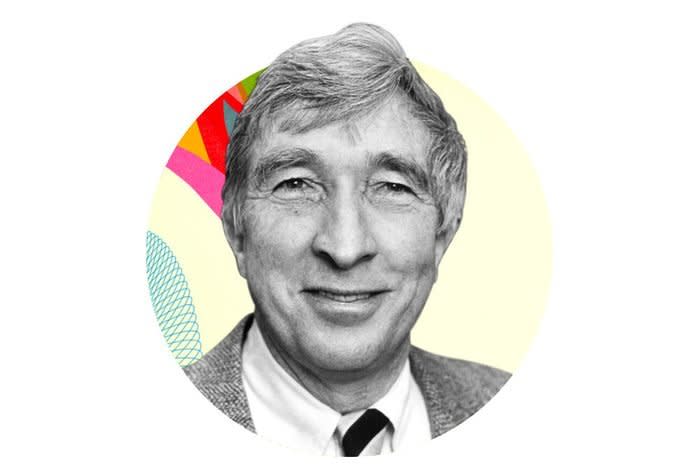
27. John Updike
The two-time Pulitzer Prize winner frequently graced our pages. In February 1997, we republished “Paranoid Packaging” from the New Yorker, sharing Updike’s commentary on one of America’s most vexing issues: how increasingly hard it is to open things. “All this time, childproof pill bottles had been imperceptibly toughening and complicating, to the point where only children had the patience and eyesight to open them.”
28. “Amy’s Choice” by Rena Dictor LeBlanc, September 2000
A 19-year-old fights for—and eventually wins—custody of her four younger siblings, managing to keep the family together after her drug-addicted mother landed in prison. The story spurred hundreds of donations for the family from our readers and was adapted into a Lifetime movie, Gracie’s Choice.
29. “Runaway Train” by William M. Hendryx, March 2002
Through an improbable series of events, a locomotive carrying 200 tons of molten phenol barrels down a busy railroad at 50 miles per hour with no conductor at the helm, doomed to crash once it reaches the residential town of Kenton, Ohio. Can a seasoned conductor and the new guy catch it? The ending may already be spoiled if you saw the 2010 film Unstoppable, starring Denzel Washington and Chris Pine, inspired by this story.

30. P. J. O’Rourke
The beloved satirist is unafraid to challenge core American values, from why “The Beach Is for the Birds” (July/August 2017) to the two-party system in this Point to Ponder: “The Democrats are the party that says government will make you smarter, taller, richer, and remove the crabgrass on your lawn. The Republicans are the party that says government doesn’t work, then they get elected and prove it.”
31. “The Nicest Places in America,” November 2017 to November 2021
In 2017, Reader’s Digest launched our Nicest Places in America contest, a nationwide search for places around the country where people come together and kindness and civility win, even in the face of challenges. Our Nicest Places, through the years: Gallatin, Tennessee (2017), Yassin’s Falafel House in Knoxville, Tennessee (2018), Columbiana, Ohio (2019), Buchanan, Michigan (2020), and The Quality Inn in Kodak, Tennessee (2021). For the past five years, our readers have inspired us, nominating thousands of towns, neighborhoods, stores, and even front porches with stories that demonstrate the best of humanity. And we’re ramping up for 2022’s Nicest Places in America—nominate your favorite place at rd.com/nicest. We might add it to our list.
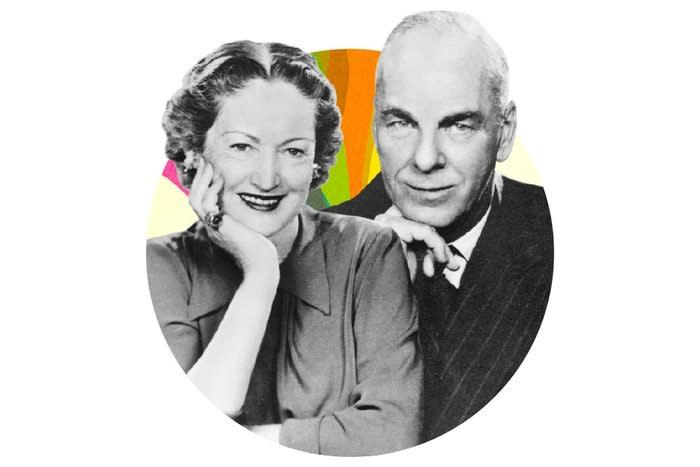
32. Lila and DeWitt Wallace
Last but very not least: the Wallaces. If the 2020s have Jack Dorsey, the 1920s had the Wallaces. The founders of Reader’s Digest and the world’s first “content curators” collected the very best in print, condensing it all into “the Reader’s Digest version.”
Next, check out the lasting impact of Alex Haley’s Roots as told by Henry Louis Gates Jr.
Vintage Reader's Digest Covers
100 Years of the Funniest Quotes
Funniest Jokes from the Past 100 Years
The post 32 of the Most Memorable Reader’s Digest Stories Ever appeared first on Reader's Digest.

